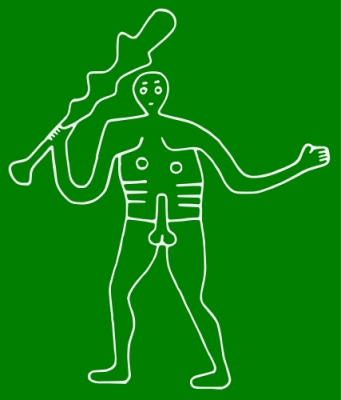To search the RPR site click here
There is correspondence in the Salisbury and South Wiltshire Museum's Pitt-Rivers papers relating to the village and figure at Cerne Abbas, Dorset. See L615-616 from Gundry, L622 with enclosure from E. Norman. Pitt-Rivers had two interests in the figure, he was Inspector of Ancient Monuments and he was also a local landowner.
Pitt-Rivers inherited Cerne Abbas with his other Dorset properties in 1880. As this PDF makes clear, '... in 1880 ... the estates devolved upon the Lane-Fox descendants of Marcia Pitt (a daughter of the 1st Baron) who had married James Lane Fox in 1789. The Lane-Fox in 1880 was Lieutenant–General August Henry Lane Fox, ... With his death in 1900 the estates passed to his son, Alexander Edward Pitt, who took the additional name of Rivers by Royal Licence. Very heavy death duties had been levied on the death of the General and it became apparent that parts of the estate would have to be sold to meet them. As a result Cerne Abbas was sold at auction by the Pitt-Rivers family in 1919. This was as defining a moment in the village’s history as the Dissolution of 1539. The sale raised £67,402 for the family, many of the properties being sold to the tenants'.
In the National Archives workbook 39/ 8 there is evidence that he had given some thoughts to the iconography of the figure:
Page 3-4
Figures of Hercules in the B.M. [British Museum]
for comparison with the Cerne giant
The figures have always the club in right hand
it is usually knotted
the left hand is usually turned out like the Cerne giant but it nearly always has the lions skin [illegible] on it the private parts area always shewn some have a serpent in the left hand
It would seem that during Pitt-Rivers' ownership the Giant figure was cleaned in 1887 by Jonathan Hardy [according to 'Prehistoric Britain from the air: a study of space, time and society', Timothy Darvill 1996 page 225]. According to this site, the navel of the figure was lost at this time. According to the same site, the Pitt-Rivers family gave the figure to the National Trust in 1920. Other notes in the above National Archives workbook relate to 1887 so it seems likely that Pitt-Rivers wrote the iconography at about the time of the cleaning of the figure. The figure has to be cleaned regularly if the figure is to remain visible, see here for further information.
Three of the paintings in Pitt-Rivers' own collection were of Cerne Abbas. They were listed as
8. 'Street in Cerne Abbas. By Mr. Yeend King, R.I.'
9. 'The Manor House, Cerne Abbas'. By Mr. Yeend King, R.I.
10. 'The Mill Stream, Cerne Abbas, Dorset'. By Mr. Yeend King, R.I.
in his catalogue for his 1985 Art Exhibition held at the Larmer Ground in September 1895. These do not appear to be listed in the Pitt-Rivers' family art catalogue.
He also acquired at least 10 items from Cerne Abbas, Add.9455vol2_p337 /4 'A piece of Gothic stone carving from Cerne abbey [Drawing] Crockett', Add.9455vol2_p337 /5 A female face carved in stone from Cerne Abbey [Drawing], Add.9455vol2_p337 /6-11 6 Tiles from Cerne, one without pattern From Cerne Abbey, Add.9455vol2_p595 /4 Bought of Rollin & Feuardent 19 Bloomsbury Street W.C. A collection of Dorset Tokens as below:- The numbers preceding the description agree with those in Boyne’s Tokens page 61 ... CERNE ABBAS No 32 obv IOHN RANDOLL the Grocer’s Arms Rev OF CERNE ABBAS I.R. The following item is now in Salisbury and South Wiltshire Museum's collection but not listed in the CUL catalogue of the second collection: 'SBYWM: 4.484 Model of carpenter's bench, a 'jackass' used as a spoke shave and draw-knife to make ladder rungs, sheep cribs, rack staves etc to compare with similar one from Austria, from Cerne Abbas in Dorset.'
National Archives workbook 39/9 contains details of some surveys Pitt-Rivers carried out around Cerne as Inspector of Ancient Monuments, probably in 1887.
According to this site in 1919 the Pitt-Rivers family sold the Cerne Abbas estate and their connection with the neighbourhood ceased.
See also 'Dorset Folklore Collected in 1897' H. Colley March, Folklore, Vol. 10, No. 4 (Dec., 1899), pp. 478-489 and http://www.nationaltrust.org.uk/main/w-vh/w-visits/w-findaplace/w-cernegiant.htm
AP October 2011




